Overview
The Violet Factor is one of the most admired color modifiers in budgies, responsible for creating the deep violet and purple tones that many people find mesmerizing. Despite its appearance, violet is not a base color, but rather a modifier gene that enhances the budgie’s existing body color. It can turn a simple cobalt budgie into a rich, royal violet bird or add a lavender tone to a sky blue budgie.
However, this effect is almost invisible in green-based budgies. Because of how pigments interact, the yellow pigment in green birds masks the violet reflection entirely, making it extremely difficult to recognize violet in green series budgies.
How the Violet Factor Works
The violet factor is a semi-dominant gene, meaning it acts differently depending on whether the bird carries one or two copies of the gene.
-
A single factor violet (SF) budgie has one copy of the violet gene and shows a soft violet or lavender hue overlaying its original body color.
-
A double factor violet (DF) budgie has two copies of the gene and shows a deeper, more intense violet shade, especially when combined with cobalt
Single Factor Violet
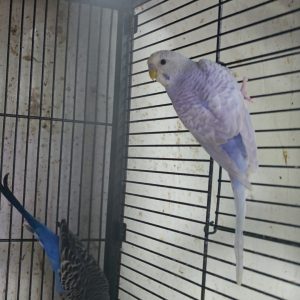
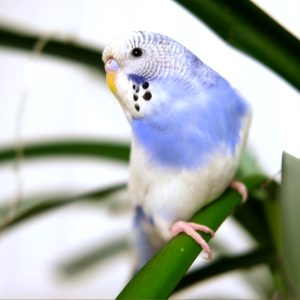
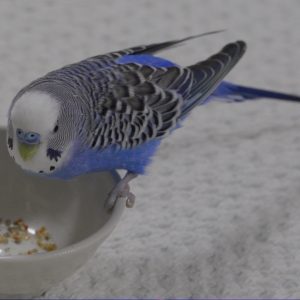
Double Factor Violet
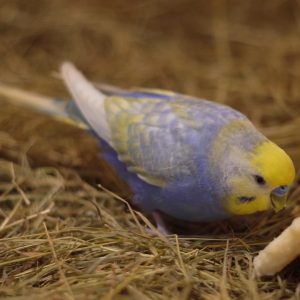
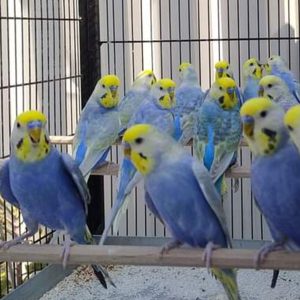
Genetic Basis
We represent the violet gene with a capital V for the dominant allele and a lowercase v for the non-violet form.
So:
-
VV = Double Factor Violet (deep, rich violet)
-
Vv = Single Factor Violet (light violet tone)
-
vv = Normal (no violet)
The violet factor mainly affects the body color of the budgie. Other features such as mask color and wing markings remain the same, although DF violets often have richer violet cheek patches.
Why Violet Doesn’t Show in Green Budgies
The violet factor is only visible in blue series budgies (sky blue, cobalt, or mauve).
In green series budgies, the yellow pigment layer masks the violet reflection. This happens because the green color in budgies is produced by yellow pigment over a blue structural layer. When violet modifies that blue layer, the result is visually lost under the yellow.
That’s why a green budgie with the violet gene may look just like an olive budgie, and without knowing its genetics, you wouldn’t be able to tell them apart.
The Science Behind It – Light and Color Analogy
To understand this better, imagine different fabrics representing body colors under violet light:
-
Green cloth: turns brownish-purple, because green cannot reflect violet light.
-
Yellow cloth: becomes reddish-pink, since it reflects red but not violet.
-
Sky blue cloth: turns lavender, resembling a sky blue budgie with a violet factor.
-
Cobalt cloth: becomes rich violet-blue, just like a cobalt violet budgie.
-
White cloth: reflects violet completely, similar to how white budgies show no change.
This simple experiment demonstrates how violet interacts with different base colors — enhancing some while being hidden in others.
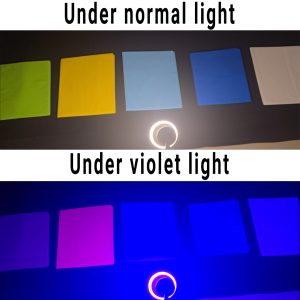
Punnett Square Examples
Example 1: Two Single Factor Violet Budgies (Vv × Vv)
| V | v | |
|---|---|---|
| V | VV (Double Factor Violet) | Vv (Single Factor Violet) |
| v | Vv (Single Factor Violet) | vv (Normal) |
Result:
25% Double Factor Violet
50% Single Factor Violet
25% Normal (no violet gene)
Example 2: Single Factor Violet (Vv) × Normal (vv)
| v | v | |
|---|---|---|
| V | Vv (Single Factor Violet) | Vv (Single Factor Violet) |
| v | vv (Normal) | vv (Normal) |
Result:
50% Single Factor Violet
50% Normal
Why Violet Budgies Are So Popular
Violet budgies are often described as some of the most beautiful color variations ever produced. Their deep purple tones, enhanced cheek patches, and the way light plays on their feathers make them highly desirable in both pet and exhibition breeding.
Breeders frequently pair cobalt budgies with the violet factor to produce the classic “show violet” birds known for their rich plum coloration and intense vibrance.
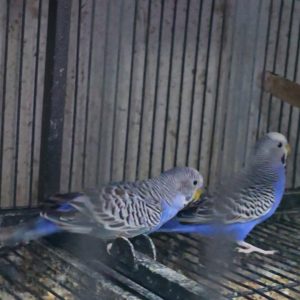
Summary
-
The Violet Factor is a semi-dominant gene that modifies the budgie’s body color.
-
Single Factor produces a light violet tint, while Double Factor produces a deep royal violet.
-
It only shows clearly on blue series budgies, as yellow pigment in green birds hides the effect.
-
The gene symbols are V (violet) and v (non-violet).
-
Breeding two single-factor violets can produce DF violets, SF violets, and normals.
